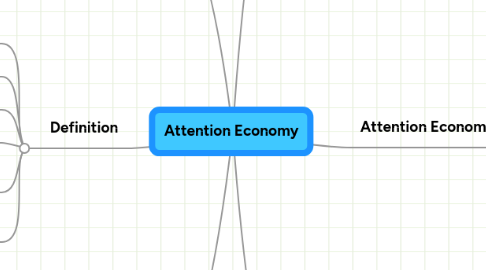
1. Definition
1.1. A marketplace where consumers agree to receive services in exchange for their attention
1.2. Points out that the consumer has a choice
1.2.1. They get to choose where to spend their attention
1.3. Relevancy
1.3.1. Customers see relevant contents, creating more opportunities to sell
1.4. Examples are personalized news, personalized search, news, alerts and recommendations
1.5. Attention Crisis
1.5.1. Being scarce in attention makes the economy weak
1.5.2. Affects new sites, blogs, search engines and online retailers
1.6. Utmost Purpose: Sell something to the consumer by stimulating attention
2. The Implicit Web
2.1. Coined in 2007
2.2. Popularized by Josh Kopelman, Fred Wilson and Brad Feld
2.3. A web of connected data
2.4. Value that is created when actions made by people in the web are recorded
2.5. Describes a network
2.5.1. implicit information which people have browsed
2.5.2. services that are listed
2.5.3. links that are clicked
2.6. Unmasks the dynamic side of human knowledge
2.6.1. Records how data, services and links are accessed
2.7. Constructs a behavior for the WWW
2.7.1. Example: Tracking what a user likes by the things that he downloads and its occurrency / pattern
2.8. A network that gathers together every piece of implicitness on the WWW
2.9. Mechanics of Implicit Web
2.9.1. Powered by clicks
3. Towards Attention Economy
3.1. Emerging Trends
3.1.1. Economy of Feeling
3.1.1.1. Uses symbols and mythology to gain more attention and enthusiasm among customers
3.1.2. Markets as Conversation
3.1.2.1. Relies on communication between individuals to create attention
3.1.2.2. "the more unique, individualized and humane the communication, the more it can generate attention..."
3.2. Users' attentions are stored in attention silos
3.2.1. Databases
3.3. Basics of Attention
3.3.1. Attention information is good for many contexts because it reveals users interests
3.4. Attention Organization
3.4.1. Attention Trust
3.4.1.1. Non-profit Organization
3.4.1.2. Ensures that users are in control
3.4.1.3. Mission of empowering people to be in control of their attention
3.4.1.4. Rooted on the importance of attention data
3.4.1.4.1. used to determine a person's preferences and actions
3.4.1.5. Enforces property, mobility, economy and transparency
3.4.1.5.1. Property: controlling attention data
3.4.1.5.2. Mobility: ability to transfer to other things
3.4.1.5.3. Economy: our choice to pay attention to something or another
3.4.1.5.4. Transparency: how we see our attention as worth
3.5. Attention Standards
3.5.1. Users should be provided by the attention silo access to information
3.5.1.1. Proprietary Format
3.5.1.2. Implementation of a way for services to get the information
4. Attention Economics
4.1. Definition
4.1.1. A new way of looking at information
4.1.2. Approach in managing information
4.1.2.1. Emphasis is on economic theory application
4.1.2.2. Reduce number of information management problems which reduce attention
4.2. History
4.2.1. Termed by Herbert Simon in 1971
4.2.1.1. "...a wealth of information creates a poverty of attention..."
4.2.1.2. too much emphasis on problem of information scarcity
4.2.1.2.1. results to IS having too much information
4.2.2. Idea common to people, like business strategists and writers
4.2.2.1. embellished terms:
4.2.2.1.1. "Attention Economy"
4.2.2.1.2. "Attention Transactions"
4.3. Relationship with Advertising
4.3.1. Used to get consumers to consume advertising
4.3.2. AIDA process
4.3.2.1. Attention, Interest, Desire, Action
4.3.2.2. Concept of having too much information, causing overload.
4.3.2.3. Resulted in the creation of AttentionTrust.org
4.4. Applications
4.4.1. Controlling Information Pollution
4.4.2. E-mail Spam
4.4.3. Web Spam
4.4.4. Sales Lead Generation
5. Technology of Attention
5.1. Tagging
5.1.1. Attention is rooted by indicating common tags
5.2. Related to Web 2.0
5.2.1. Internet focuses on what people really need. An environment which is:
5.2.1.1. interactive
5.2.1.2. social
5.2.1.3. garners attention of people
5.3. Kinds of Attention
5.3.1. Implicit
5.3.1.1. Example: clickstream
5.3.2. Explicit
5.3.2.1. Example: bookmarks
6. Continuous Partial Attention: Software and Solutions
6.1. "Doing a lot of work and at the same time knowing a few things continuously about all your actions"
6.2. Examples: Texting, Reading to Skimming books
6.3. To pay attention to everything but give just a small portion of attention to the gravity of the work being done
6.4. Roots
6.4.1. Created because of the amount of information and the interruptions
6.4.2. "Broadband gives a lot of information, often leading to interruptions in other things like personal life"
6.5. Iterations - The New Way We Work
6.5.1. Looking at the best logical and theoretical way of solving a problem
6.5.2. Leads to less time and costs
6.6. Software for Iterative Mode
6.6.1. Calendar
6.6.2. E-mail
6.6.3. Project Management
